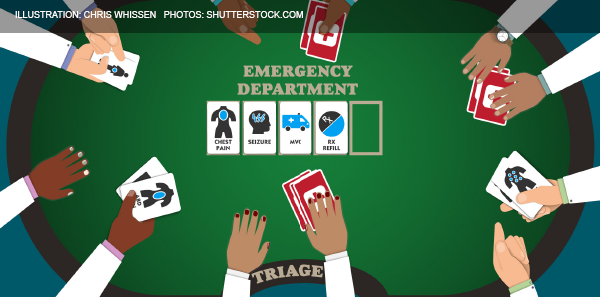
Rotational: This employs a rotation system with patient assignments made in a planned sequence.
Explore This Issue
ACEP Now: Vol 36 – No 09 – September 2017Zone Assignments: Analogous to zone nursing, the physician staffs a zone. Zones can receive distributed patients by rotation, acuity, or chief complaint.
Team Assignments: A team including a physician, nurse(s), tech(s), PAs (in some models), a health unit coordinator, and a scribe inhabits a geographic zone and receives patients into that zone.
Workload Feeding: One of the newest and most innovative systems for patient assignment, this is currently being studied at several sites. It involves sophisticated information technology with a “smart tracker” forecasting the workload and assigning patients accordingly.7
Most departments have no real-time mechanisms for identifying when the workload challenging providers is unsafe or for physicians to indicate their work threshold. The system has no means for recognizing and responding to the changing conditions of patients, such as when patients unexpectedly become unstable.
Most departments have no system in place for physicians to indicate their work threshold.
One intriguing solution has been employed by Intermountain Medical Center in Salt Lake City. It developed the ability for providers to communicate on the ED tracking system (by a physician or a nurse) when a zone is “at capacity,” regardless of bed vacancy. An icon on the tracking system suggests to the triage nurse and the patient flow coordinator that the staff in that area feel it would be unsafe to send another patient to their zone or team.
These are the types of technology tools that all physicians will employ in the future. Ultimately, physicians will have the capability to objectively calculate, using Emergency Severity Index scales, chief complaint data, and utilization measures, the work being done in a zone by a team or a provider and manage workloads more effectively. Workloads should never be unsafe or unsustainable!
References
- Kilner E, Sheppard LA. The role of teamwork and communication in the emergency department: a systematic review. Int Emerg Nurs. 2010;18(3):127-137.
- Shetty A, Gunja N, Byth K, et al. Senior streaming assessment further evaluation after triage zone; a novel model of care encompassing various emergency department throughput measures. Emerg Med Australasia. 2012;24(4):374-382.
- Gurses AP Carayon P, Wall M. Impact of performance obstacles on intensive care nurses’ workload, perceived quality and safety of care, and quality of working life. Health Serv Res. 2009;44(2):422-443.
- D’Amico A, Bazzano N, Butterfield J, et al. Doing an extreme makeover of patient flow: going from condition red to green in one week (or less). Institute for Healthcare Improvement website. Accessed June 3, 2017.
- Asha SE, Ajami A. Improvement in emergency department length of stay using an early senior medical assessment and streaming model of care: a cohort study. Emerg Med Australas. 2013;25(5):445-451.
- Jones SS, Allen TL, Flottemesch TJ, et al. An independent evaluation of four quantitative emergency department crowding scales. Acad Emerg Med. 2006;13(11):1204-1211.
- Jones SS, Thomas A, Evans RS, et al. Forecasting daily patient volumes in the emergency department. Acad Emerg Med. 2008;15(2):159-170.
Pages: 1 2 3 | Single Page





No Responses to “Tips for Managing Heavy Workloads in the Emergency Department”